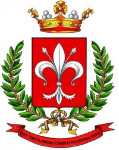Casa della Memoria
Ultimo aggiornamento: 18 ottobre 2023, 13:11
Argomenti :
Tempo libero
Turismo
Casa della Memoria
Questo memoriale sorge tra i resti di una costruzione bombardata durante la Seconda Guerra Mondiale. Il percorso è stato inaugurato il 25 aprile 2003 (Festa della Liberazione d'Italia), nello stesso giorno in cui alla Città è stata conferita da parte del Presidente della Repubblica, Carlo Azeglio Ciampi, la Medaglia d’Oro al Merito Civile.
Questo memoriale sorge tra i resti di una costruzione bombardata durante la Seconda Guerra Mondiale. Il percorso è stato inaugurato il 25 aprile 2003 (Festa della Liberazione d'Italia), nello stesso giorno in cui alla Città è stata conferita da parte del Presidente della Repubblica, Carlo Azeglio Ciampi, la Medaglia d’Oro al Merito Civile.
E' ancora viva tra i ferentinati la memoria della sirena d'allarme che annunciava i bombardamenti, iniziati il 30 dicembre 1943 fino a tutto il mese di maggio 1944, dell’accoglienza degli sfollati provenienti dai Comuni del Cassinate, delle corse verso i rifugi - come lo era il Criptoportico sull'Acropoli, che ospita la mostra permanente “Il Valore della Memoria”, con le gigantografie sulle devastazioni e rovine della città.
Dopo il 25 luglio 1943 si insediò in città una piccola guarnigione tedesca, che avrebbe occupato edifici pubblici e privati, creato collegamenti telefonici sospesi e riempito di armi e munizioni gli scantinati del Collegio Martino Filetico.
Il 27 Novembre ci fu la prima retata per uomini da inviare al lavoro sul fronte di Cassino: il traffico militare tedesco aumentava, e con esso furti e requisizioni.
Il 27 Novembre ci fu la prima retata per uomini da inviare al lavoro sul fronte di Cassino: il traffico militare tedesco aumentava, e con esso furti e requisizioni.
Il 30 dicembre si tramanda la prima incursione aerea degli Alleati (5 vit- time civili), così come il 22 gennaio (oltre 50 morti), 17 febbraio (ulteriori 8 vittime) e 17 marzo.
Gran parte della popolazione abbandonò la città.
Gran parte della popolazione abbandonò la città.
Il 20 maggio i tedeschi iniziarono la ritirata da Cassino verso nord: al fine di tagliare le retrovie e distruggere la Via Casilina, gli Alleati ridussero Ferentino ad un cumulo di macerie la notte del 24 maggio 1944.
Ripetuti bombardamenti si susseguirono il 25, 26, 29 e 31 maggio: anche i soccorritori finirono sotto le macerie.
All’alba del 2 giugno 1944 le avanguardie canadesi arrivarono a Ferentino e si poterono contare le vittime: quasi 400, tra le quali molti profughi sfollati.
All’alba del 2 giugno 1944 le avanguardie canadesi arrivarono a Ferentino e si poterono contare le vittime: quasi 400, tra le quali molti profughi sfollati.
Con la Casa del Memoriale, in cui si svolgono celebrazioni annuali, i Cittadini di Ferentino hanno inteso rendere perenne il segno della guerra nel tessuto vivo della Città, in modo che chiunque possa omaggiare la memoria delle vittime anche solo attraversando questo silenzioso sentiero.
ENG This memorial stands among the remains of a bombed-out building during World War II. The pathway was inaugurated on April 25, 2003 (Italian Liberation Day): the same day, the City of Ferentino was awarded Gold Medal for Civil Merit by the President of the Republic Carlo Azeglio Ciampi.
The memory of the alarm siren warning for the incoming bombings, which began on December 30, 1943 and continued until the end of May 1944, is still alive in Ferentino, along with the welcoming of displaced persons from the areas near the front in Cassino, and the frequent runs to shelters, such as the ancient Cryptoporticus on the Acropolis - space that hosts the permanent exhibit “Il Valore della Memoria” (lit. the value of remembrance).
After July 25, 1943 a small German garrison settled in the city and started to occupy public and private buildings, create suspended telephone connections and fill the basements of the Collegio Martino Filetico with weapons and ammunition.
On November 27 there was the first roundup of men to be sent at work on the front in Cassino. German military traffic increased, and therefore thefts and requisitions.
On November 27 there was the first roundup of men to be sent at work on the front in Cassino. German military traffic increased, and therefore thefts and requisitions.
The first Allied air raid (5 civilian casualties) was handed down on December 30, as well as January 22 (over 50 dead), February 17 (8 ca- sualties) and March 17.
Most of the population left the city.
Most of the population left the city.
On May 20, the Germans began their retreat northwards from Cassino: to cut off the rear lines and destroy the Via Casilina, the Allies bombed Ferentino, turning it in a pile of rubble on the night of May 24, 1944.
Repeated bombings by the Allies followed on 25, 26, 29, and 31 May with even the rescuers ending up buried in the debris.
At dawn on June 2, 1944, the Canadian avant-gardes arrived in Ferentino: there was little space for sorrow, it was time to locate the 400 victims - many of them nameless among displaced refugees - and give them proper burial.
At dawn on June 2, 1944, the Canadian avant-gardes arrived in Ferentino: there was little space for sorrow, it was time to locate the 400 victims - many of them nameless among displaced refugees - and give them proper burial.
With the Memorial House, where annual celebrations are held, the sign of war has become permanent in the living fabric of the city, so that anyone can pay homage to the memory of the victims even just by crossing this silent path.
